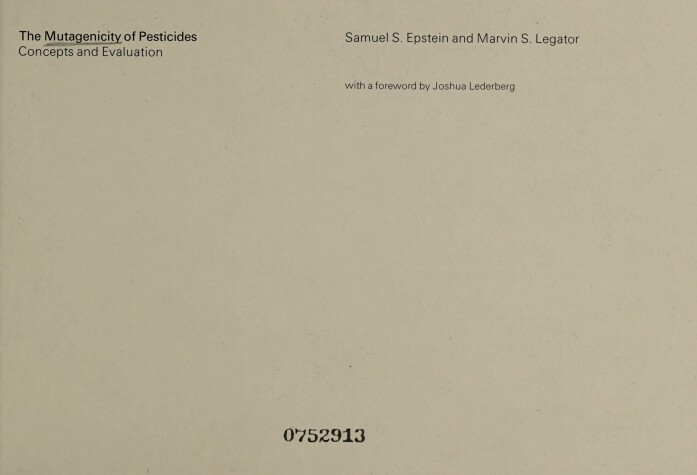"There are now about 400 substances that, in various forms and combinations, are used as pesticides. It is feasible to test all of these in the near future for mutagenicity in systems that are simple and precise, and yet relevant to man."Mutation is defined in this book as any inherited alteration in genetic material which in future generations may lead to a wide range of irreversible abnormalities. There is a growing concern that chemical mutagens may not only pose a potential public health hazard, but that some chemicals may constitute as great a risk as radiation--possibly a more serious one. This is the first book to present recently developed mammalian methodologies for evaluating mutagenic hazards of chemicals such as pesticides. The authors explain that in most cases it is not the initial compound but the metabolic products of a pesticide which will cause trouble. The critical needs for metabolic data in toxicologic testing in general and in mutagenicity testing in particular was emphasized by Dr. Joshua Lederberg in a foreword...".we can calculate that at least 25 percent of our health burden is of genetic origin. This figure is a very conservative estimate in view of the genetic component of such griefs as schizophrenia, diabetes, atherosclerosis, mental retardation, early senility and man congenital malformations. In fact, the genetic factor in disease is bound to increase to an even larger proportion, for as we deal with infectious disease and other environmental insults, the genetic legacy of the species will compete only with traumatic accidents as the major factor in health.... Given how many new, suspicious compounds now pervade the environment, we face a formidable task in putting our genetic house in order."This study is based on the Report of the Advisory Panel on Mutagenicity of Pesticides to the Secretary's Commission on Pesticides and their Relationship to Environmental Health. The Panel was composed of internationally recognized authorities in chemical mutagenesis, mutagenicity testing and toxicology. It has been greatly modified since the original HEW report (1969) and includes tabulations and a cross index of 370 pesticides listed by their common names and synonyms, chemical name and formula (illustrated), major uses, and manufacturers. There is also a literature review on mutagenicity of pesticides which includes the name of the pesticide, the organism in which it was tested, assay system, range, effective minimum dose, and biological effect. For example: CAPTAN (orthocide) is used as a protectant eradicant fungicide for fruits, vegetables, and flowers in control of scabs, blotches, rots, and mildews. It is manufactured by Stauffer and by Chevron. When tested in human embryo cells (L-132 cells, range 10 mcg/ml) it effected the inhibition of DNA synthesis.In addition, the book covers structure-activity relations and usage patterns of pesticides, recommends a program for mutagenesis testing, and contains a summary of literature on mutagenicity of pesticides as well as a bibliography on mutagenic and related effects of pesticides and related compounds.
- ISBN10 0262050080
- ISBN13 9780262050081
- Publish Date 22 August 1971
- Publish Status Out of Print
- Out of Print 17 September 2010
- Publish Country US
- Publisher MIT Press Ltd
- Imprint MIT Press
- Format Hardcover
- Pages 240
- Language English
